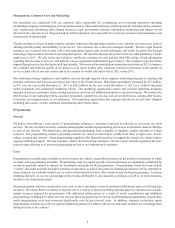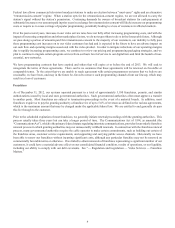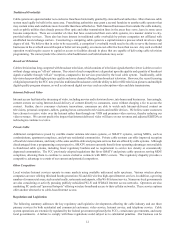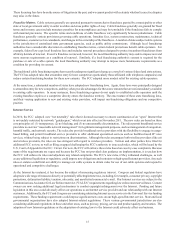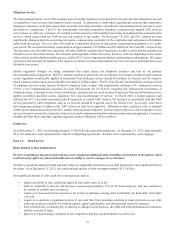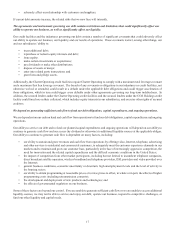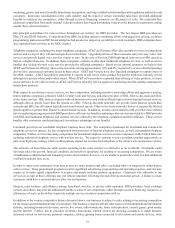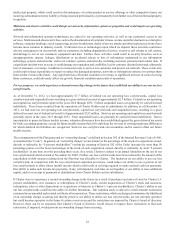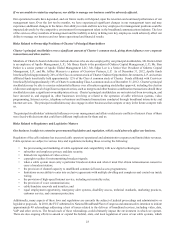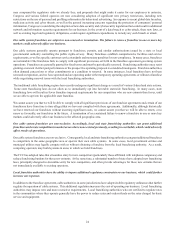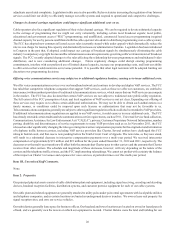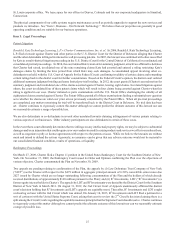Charter 2012 Annual Report Download - page 29
Download and view the complete annual report
Please find page 29 of the 2012 Charter annual report below. You can navigate through the pages in the report by either clicking on the pages listed below, or by using the keyword search tool below to find specific information within the annual report.17
• adversely affect our relationship with customers and suppliers.
If current debt amounts increase, the related risks that we now face will intensify.
The agreements and instruments governing our debt contain restrictions and limitations that could significantly affect our
ability to operate our business, as well as significantly affect our liquidity.
Our credit facilities and the indentures governing our debt contain a number of significant covenants that could adversely affect
our ability to operate our business, our liquidity, and our results of operations. These covenants restrict, among other things, our
and our subsidiaries’ ability to:
• incur additional debt;
• repurchase or redeem equity interests and debt;
• issue equity;
• make certain investments or acquisitions;
• pay dividends or make other distributions;
• dispose of assets or merge;
• enter into related party transactions; and
• grant liens and pledge assets.
Additionally, the Charter Operating credit facilities require Charter Operating to comply with a maximum total leverage covenant
and a maximum first lien leverage covenant. The breach of any covenants or obligations in our indentures or credit facilities, not
otherwise waived or amended, could result in a default under the applicable debt obligations and could trigger acceleration of
those obligations, which in turn could trigger cross defaults under other agreements governing our long-term indebtedness. In
addition, the secured lenders under the Charter Operating credit facilities and the secured lenders under the CCO Holdings credit
facility could foreclose on their collateral, which includes equity interests in our subsidiaries, and exercise other rights of secured
creditors.
We depend on generating sufficient cash flow to fund our debt obligations, capital expenditures, and ongoing operations.
We are dependent on our cash on hand and cash flow from operations to fund our debt obligations, capital expenditures and ongoing
operations.
Our ability to service our debt and to fund our planned capital expenditures and ongoing operations will depend on our ability to
continue to generate cash flow and our access (by dividend or otherwise) to additional liquidity sources at the applicable obligor.
Our ability to continue to generate cash flow is dependent on many factors, including:
• our ability to sustain and grow revenues and cash flow from operations by offering video, Internet, telephone, advertising
and other services to residential and commercial customers, to adequately meet the customer experience demands in our
markets and to maintain and grow our customer base, particularly in the face of increasingly aggressive competition, the
need for innovation and the related capital expenditures and the difficult economic conditions in the United States;
• the impact of competition from other market participants, including but not limited to incumbent telephone companies,
direct broadcast satellite operators, wireless broadband and telephone providers, DSL providers and video provided over
the Internet;
• general business conditions, economic uncertainty or downturn, high unemployment levels and the level of activity in
the housing sector;
• our ability to obtain programming at reasonable prices or to raise prices to offset, in whole or in part, the effects of higher
programming costs (including retransmission consents);
• the development and deployment of new products and technologies; and
• the effects of governmental regulation on our business.
Some of these factors are beyond our control. If we are unable to generate sufficient cash flow or we are unable to access additional
liquidity sources, we may not be able to service and repay our debt, operate our business, respond to competitive challenges, or
fund our other liquidity and capital needs.



